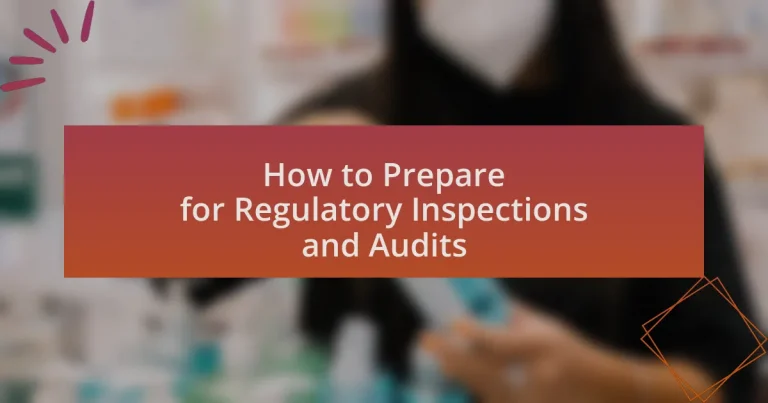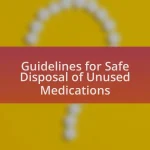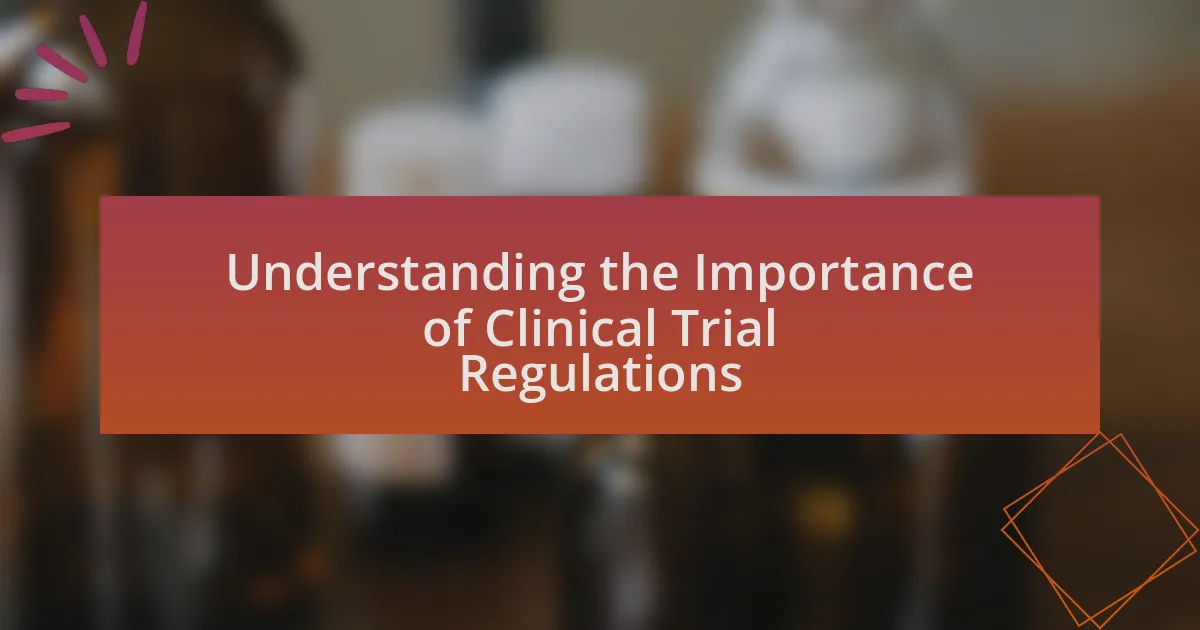Regulatory inspections and audits are critical evaluations conducted by regulatory bodies to ensure compliance with laws and standards across various industries. This article outlines the differences between inspections and audits, emphasizing their distinct purposes and objectives. It details the importance of these evaluations in safeguarding public health and safety, as well as their impact on organizational practices. Additionally, the article provides guidance on how organizations can prepare effectively for inspections and audits, including essential documentation, staff training, and best practices for responding to inquiries. Key topics include the structure of the inspection process, potential outcomes, and strategies for maintaining ongoing compliance.
What are Regulatory Inspections and Audits?
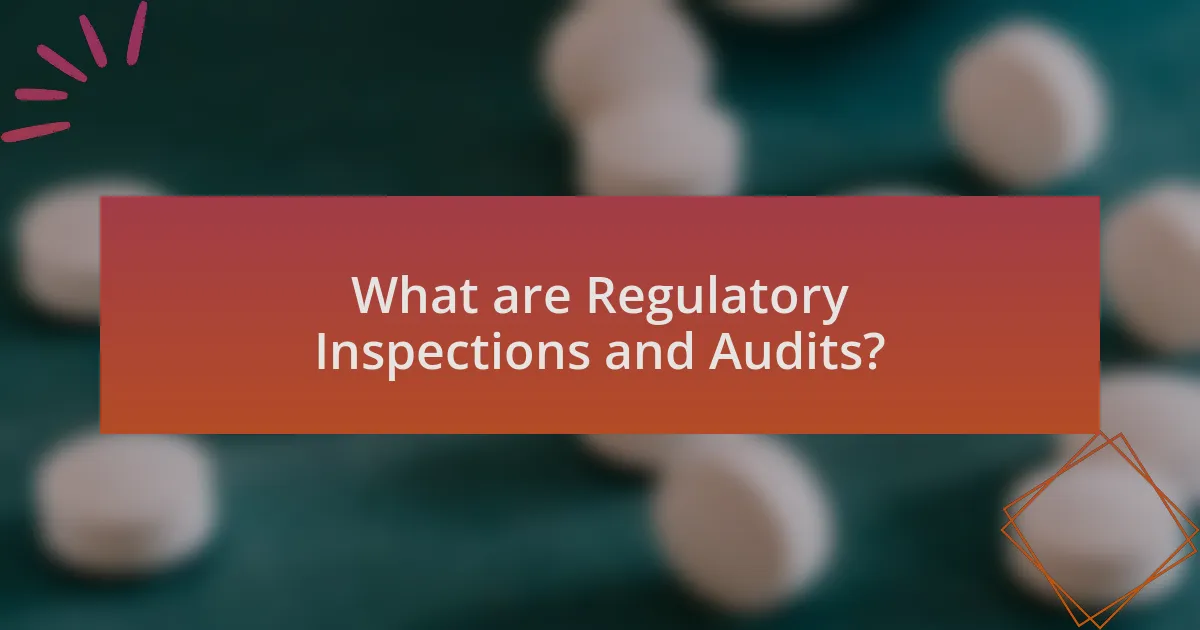
Regulatory inspections and audits are systematic evaluations conducted by regulatory bodies to ensure compliance with laws, regulations, and standards within specific industries. These evaluations assess an organization’s adherence to established guidelines, which can include safety protocols, quality control measures, and operational practices. Regulatory inspections typically involve on-site visits where inspectors review documentation, interview personnel, and observe operations, while audits may include a more comprehensive examination of financial records and internal controls. The purpose of these processes is to identify non-compliance issues, promote accountability, and enhance overall industry standards.
How do regulatory inspections differ from audits?
Regulatory inspections differ from audits primarily in their purpose and scope. Regulatory inspections are conducted by government agencies to ensure compliance with laws and regulations, focusing on specific operational practices, safety standards, and legal requirements. In contrast, audits are typically internal or external evaluations aimed at assessing the effectiveness of an organization’s processes, financial statements, or compliance with internal policies. Regulatory inspections often involve unannounced visits and can result in immediate corrective actions, while audits are usually planned in advance and may lead to recommendations for improvement rather than immediate enforcement actions.
What are the key objectives of regulatory inspections?
The key objectives of regulatory inspections are to ensure compliance with laws and regulations, assess the effectiveness of operational processes, and identify areas for improvement. Regulatory bodies conduct these inspections to verify that organizations adhere to established standards, thereby safeguarding public health, safety, and welfare. For instance, in the pharmaceutical industry, inspections aim to confirm that companies follow Good Manufacturing Practices (GMP), which are critical for maintaining product quality and safety.
What are the primary goals of audits?
The primary goals of audits are to ensure accuracy, compliance, and efficiency in financial reporting and operational processes. Audits assess whether an organization’s financial statements present a true and fair view of its financial position, ensuring adherence to applicable laws and regulations. Additionally, audits identify areas for improvement in internal controls and operational efficiency, which can lead to enhanced risk management and resource allocation. These goals are supported by the requirement for organizations to undergo regular audits as mandated by regulatory bodies, ensuring transparency and accountability in financial practices.
Why are regulatory inspections and audits important?
Regulatory inspections and audits are important because they ensure compliance with laws and regulations, thereby safeguarding public health and safety. These evaluations help identify potential risks and non-compliance issues within organizations, which can lead to corrective actions and improvements in operational practices. For instance, in the pharmaceutical industry, the U.S. Food and Drug Administration conducts inspections to verify that companies adhere to Good Manufacturing Practices, ultimately protecting consumers from unsafe products.
How do they ensure compliance with regulations?
They ensure compliance with regulations through systematic monitoring and adherence to established guidelines. Organizations implement compliance programs that include regular audits, employee training, and the establishment of clear policies and procedures aligned with regulatory requirements. For instance, companies often utilize compliance management software to track adherence to laws such as the Sarbanes-Oxley Act or the General Data Protection Regulation, which helps in identifying potential areas of non-compliance and addressing them proactively.
What impact do they have on organizational practices?
Regulatory inspections and audits significantly impact organizational practices by enforcing compliance with legal and industry standards. These evaluations compel organizations to establish robust internal controls, enhance documentation processes, and foster a culture of accountability. For instance, organizations that prepare for audits often implement systematic procedures to ensure adherence to regulations, which can lead to improved operational efficiency and risk management. Additionally, studies show that companies with strong compliance frameworks experience fewer violations and penalties, reinforcing the importance of regulatory oversight in shaping effective organizational practices.
What types of organizations are subject to regulatory inspections and audits?
Organizations that are subject to regulatory inspections and audits include healthcare facilities, financial institutions, manufacturing companies, and educational institutions. Healthcare facilities, such as hospitals and clinics, are inspected to ensure compliance with health regulations and standards. Financial institutions, including banks and credit unions, undergo audits to verify adherence to financial regulations and anti-money laundering laws. Manufacturing companies are subject to inspections to confirm compliance with safety and environmental regulations. Educational institutions, particularly those receiving federal funding, are audited to ensure compliance with educational standards and regulations.
Which industries face the most scrutiny?
The industries that face the most scrutiny include finance, healthcare, pharmaceuticals, and energy. These sectors are heavily regulated due to their significant impact on public safety, economic stability, and environmental concerns. For instance, the financial industry is subject to strict regulations to prevent fraud and ensure transparency, as evidenced by the Dodd-Frank Act implemented after the 2008 financial crisis. Similarly, the healthcare and pharmaceutical industries are closely monitored to ensure compliance with safety standards and ethical practices, highlighted by the rigorous approval processes enforced by the FDA. The energy sector faces scrutiny primarily due to environmental regulations aimed at reducing pollution and promoting sustainable practices, as seen in the implementation of the Clean Air Act.
What are the common regulatory bodies involved?
Common regulatory bodies involved in inspections and audits include the Food and Drug Administration (FDA), the European Medicines Agency (EMA), and the Occupational Safety and Health Administration (OSHA). These organizations oversee compliance with health, safety, and environmental regulations. For instance, the FDA regulates food safety and pharmaceuticals in the United States, while the EMA ensures the efficacy and safety of medicines in the European Union. OSHA focuses on workplace safety standards, enforcing regulations to protect employees.
How to Prepare for Regulatory Inspections and Audits?
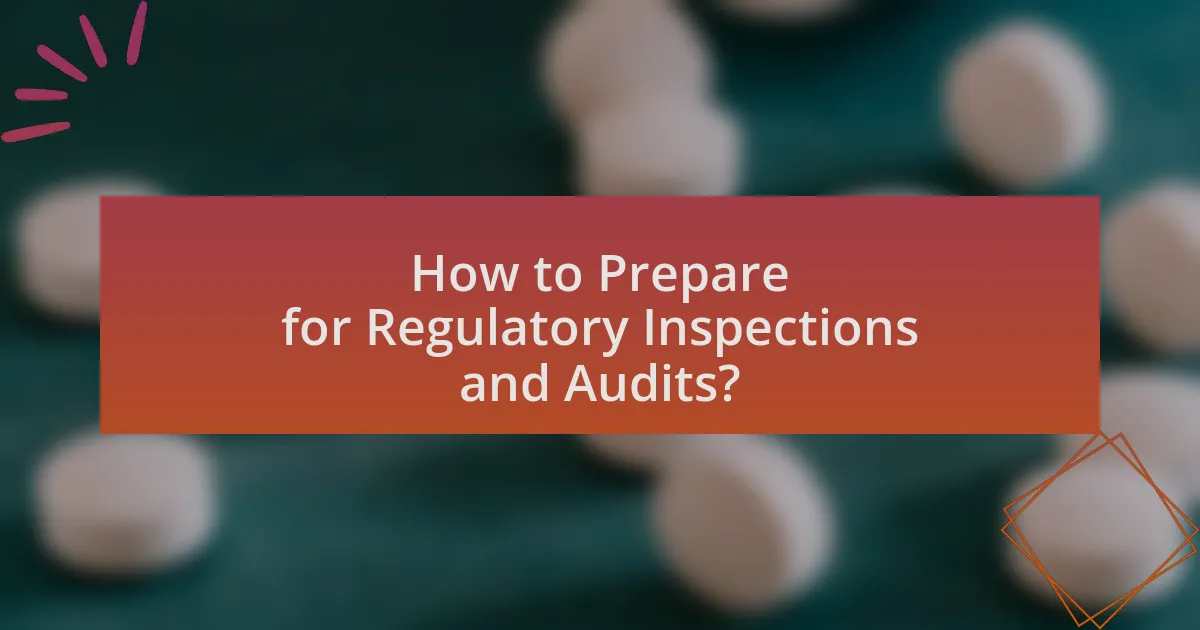
To prepare for regulatory inspections and audits, organizations should conduct thorough internal reviews and ensure compliance with relevant regulations. This involves reviewing documentation, training staff on compliance requirements, and maintaining accurate records. For instance, the FDA recommends that companies implement a quality management system to facilitate adherence to regulations, which can significantly reduce the risk of non-compliance during inspections. Regular mock audits can also help identify potential issues before the actual inspection, allowing organizations to address them proactively.
What are the initial steps in preparing for an inspection or audit?
The initial steps in preparing for an inspection or audit include assembling a dedicated team, reviewing relevant documentation, and conducting a pre-inspection assessment. Assembling a dedicated team ensures that all necessary personnel are involved and informed about their roles during the inspection or audit process. Reviewing relevant documentation, such as policies, procedures, and previous audit reports, helps identify areas that may require attention or improvement. Conducting a pre-inspection assessment allows the organization to evaluate its current compliance status and address any potential issues before the actual inspection or audit occurs. These steps are critical for ensuring a smooth and successful inspection or audit process.
How can organizations conduct a self-assessment?
Organizations can conduct a self-assessment by systematically evaluating their compliance with regulatory requirements and internal policies. This process typically involves establishing clear criteria based on relevant regulations, gathering data through surveys or audits, and analyzing the findings to identify gaps or areas for improvement. For instance, organizations may utilize checklists aligned with specific regulations, such as the Sarbanes-Oxley Act, to ensure all necessary controls are in place. Additionally, benchmarking against industry standards can provide context for the assessment results, allowing organizations to measure their performance relative to peers.
What documentation is essential for preparation?
Essential documentation for preparation includes standard operating procedures (SOPs), training records, quality management system documents, and previous audit reports. These documents provide a comprehensive overview of compliance practices and operational standards. SOPs outline the processes that must be followed, ensuring consistency and adherence to regulations. Training records demonstrate that staff are adequately trained in relevant procedures, which is crucial for compliance. Quality management system documents reflect the organization’s commitment to maintaining quality standards. Previous audit reports offer insights into past findings and corrective actions taken, helping to identify areas for improvement. Collectively, these documents form a robust foundation for effective preparation for regulatory inspections and audits.
How can staff be trained for inspections and audits?
Staff can be trained for inspections and audits through structured training programs that include both theoretical knowledge and practical exercises. These programs should cover relevant regulations, compliance standards, and the specific procedures required during inspections and audits. Incorporating real-life scenarios and role-playing can enhance understanding and retention of the material. Additionally, regular refresher courses and updates on regulatory changes ensure that staff remain informed and prepared. Evidence shows that organizations with comprehensive training programs experience fewer compliance issues and improved audit outcomes, as highlighted in studies by the Institute of Internal Auditors, which emphasize the importance of ongoing education in maintaining compliance and readiness for inspections.
What key topics should training cover?
Training should cover key topics such as regulatory requirements, audit processes, compliance standards, documentation practices, and risk management strategies. These topics are essential for ensuring that personnel understand the legal and procedural frameworks governing their operations. For instance, knowledge of specific regulations like the FDA guidelines or ISO standards is crucial for maintaining compliance during inspections. Additionally, training on effective documentation practices helps organizations prepare accurate records that auditors review, thereby reducing the risk of non-compliance. Understanding risk management strategies equips employees to identify and mitigate potential issues before they arise, enhancing overall preparedness for regulatory inspections and audits.
How can role-playing scenarios enhance readiness?
Role-playing scenarios enhance readiness by simulating real-life situations that individuals may encounter during regulatory inspections and audits. This experiential learning method allows participants to practice responses, develop critical thinking skills, and improve communication under pressure. Research indicates that active participation in role-playing can lead to a 70% retention rate of learned material, compared to 10% for traditional lectures, thereby reinforcing knowledge and preparedness. Additionally, role-playing fosters teamwork and collaboration, essential for navigating complex regulatory environments effectively.
What are common pitfalls to avoid during preparation?
Common pitfalls to avoid during preparation for regulatory inspections and audits include inadequate documentation, lack of staff training, and failure to conduct mock audits. Inadequate documentation can lead to non-compliance findings, as regulatory bodies require clear and comprehensive records to verify adherence to standards. Lack of staff training results in employees being unprepared to answer questions or provide necessary information during the inspection, which can hinder the process. Additionally, failing to conduct mock audits prevents organizations from identifying gaps in their processes and addressing them before the actual inspection, increasing the risk of negative outcomes.
How can organizations ensure all documentation is up-to-date?
Organizations can ensure all documentation is up-to-date by implementing a systematic review process that includes regular audits and updates. This process involves assigning responsibility to specific team members for maintaining documentation, establishing a schedule for periodic reviews, and utilizing document management systems that track changes and versions. Research indicates that organizations that adopt such structured approaches experience a 30% reduction in compliance-related issues, as highlighted in the “Impact of Document Management on Compliance” study by Smith and Johnson (2022).
What are the risks of inadequate communication among staff?
Inadequate communication among staff can lead to significant risks, including misunderstandings, errors in task execution, and decreased overall efficiency. These risks manifest when team members lack clarity on roles, responsibilities, and expectations, which can result in compliance failures during regulatory inspections and audits. For instance, a study by the Institute for Healthcare Improvement found that poor communication is a leading cause of medical errors, which can have serious implications for patient safety and regulatory compliance. Additionally, ineffective communication can foster a culture of mistrust and disengagement, further complicating teamwork and collaboration essential for meeting regulatory standards.
What to Expect During Regulatory Inspections and Audits?
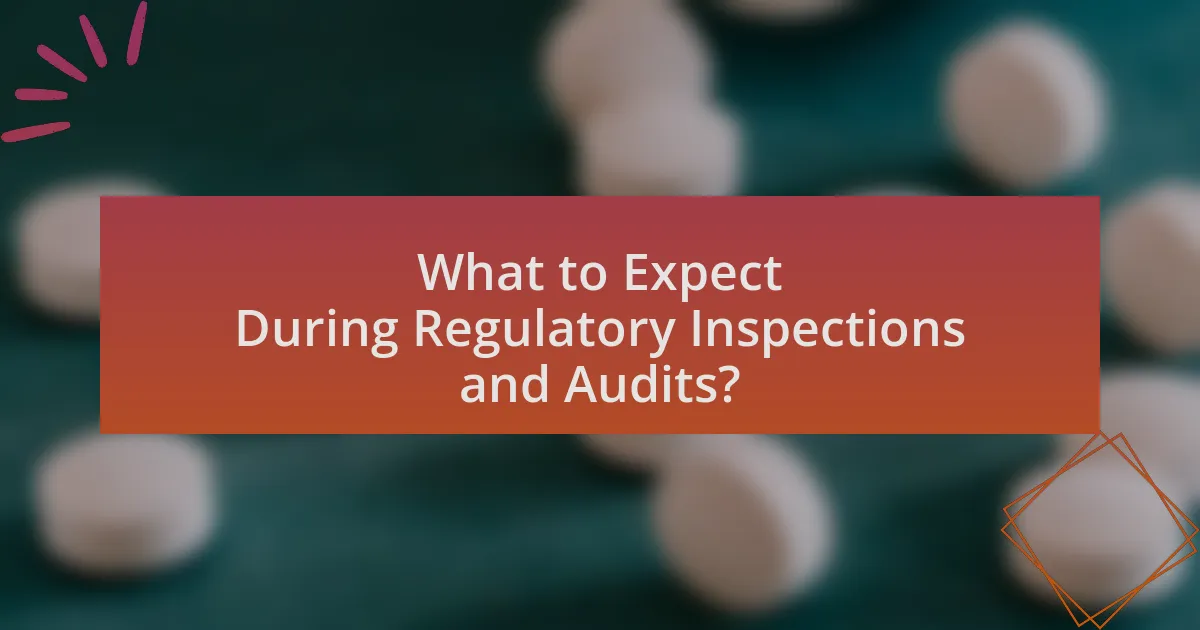
During regulatory inspections and audits, organizations can expect a thorough examination of their compliance with applicable laws and regulations. Inspectors will review documentation, interview staff, and assess operational practices to ensure adherence to standards. For instance, the FDA conducts inspections to verify compliance with the Food, Drug, and Cosmetic Act, focusing on areas such as manufacturing processes and record-keeping. This process often includes a formal opening meeting, a detailed review of relevant records, and a closing meeting to discuss findings.
How is the inspection or audit process typically structured?
The inspection or audit process is typically structured in several key phases: planning, execution, reporting, and follow-up. During the planning phase, auditors define the scope, objectives, and criteria for the audit, often involving a risk assessment to identify areas of focus. In the execution phase, auditors gather evidence through interviews, document reviews, and observations to assess compliance with regulations or standards. The reporting phase involves compiling findings, conclusions, and recommendations into a formal report, which is then communicated to relevant stakeholders. Finally, the follow-up phase ensures that corrective actions are implemented and that any identified issues are addressed, often involving a subsequent review to verify compliance. This structured approach is essential for maintaining accountability and ensuring that regulatory requirements are met effectively.
What are the phases of an inspection or audit?
The phases of an inspection or audit typically include planning, execution, reporting, and follow-up. During the planning phase, auditors define the scope and objectives, gather background information, and develop an audit plan. The execution phase involves collecting evidence through observations, interviews, and document reviews to assess compliance with regulations or standards. In the reporting phase, auditors analyze the findings, document results, and communicate them to relevant stakeholders. Finally, the follow-up phase ensures that corrective actions are implemented and assesses the effectiveness of those actions. These phases are essential for maintaining regulatory compliance and improving organizational processes.
How long do inspections and audits usually take?
Inspections and audits usually take between a few hours to several days, depending on the complexity and scope of the review. For example, a simple safety inspection may last a few hours, while a comprehensive financial audit can take several days or even weeks to complete. The duration is influenced by factors such as the size of the organization, the number of locations being inspected, and the specific regulations being assessed.
What types of questions might inspectors or auditors ask?
Inspectors or auditors typically ask questions that assess compliance with regulations, operational effectiveness, and risk management. These questions may include inquiries about adherence to specific laws, documentation practices, internal controls, and employee training programs. For example, they might ask, “Can you provide evidence of compliance with safety regulations?” or “What processes are in place to ensure data integrity?” Such questions are designed to evaluate whether an organization meets required standards and to identify areas for improvement.
How can organizations prepare for common inquiries?
Organizations can prepare for common inquiries by establishing clear protocols and training staff on compliance requirements. Implementing a structured approach ensures that employees understand the types of inquiries they may face and how to respond effectively. Regular training sessions and updates on regulatory changes enhance preparedness. Additionally, maintaining organized documentation and records allows for quick access to necessary information during inquiries. Research indicates that organizations with robust compliance programs experience fewer regulatory issues, highlighting the importance of proactive preparation.
What are the best practices for responding to questions during an audit?
The best practices for responding to questions during an audit include being honest, concise, and well-prepared. Honesty is crucial; providing accurate information builds trust with auditors and ensures compliance with regulations. Conciseness helps in delivering clear answers without unnecessary elaboration, which can lead to confusion. Preparation involves understanding the audit scope, reviewing relevant documents, and anticipating potential questions, which enhances the quality of responses. According to the Institute of Internal Auditors, effective communication during audits can significantly improve the audit process and outcomes.
What are the potential outcomes of an inspection or audit?
The potential outcomes of an inspection or audit include compliance confirmation, identification of non-compliance issues, recommendations for improvement, and potential penalties or sanctions. Compliance confirmation indicates that an organization meets regulatory standards, which can enhance its reputation and operational credibility. Identification of non-compliance issues may lead to corrective actions, allowing organizations to address deficiencies and improve processes. Recommendations for improvement can provide valuable insights for enhancing operational efficiency and compliance practices. Lastly, potential penalties or sanctions may arise if significant violations are found, impacting the organization’s financial standing and operational capabilities.
What happens if compliance is found lacking?
If compliance is found lacking, organizations may face penalties, including fines, sanctions, or legal action. Regulatory bodies enforce compliance standards to ensure safety, fairness, and accountability; thus, failure to meet these standards can lead to significant repercussions. For instance, the U.S. Securities and Exchange Commission (SEC) can impose fines that range from thousands to millions of dollars depending on the severity of the violation. Additionally, non-compliance can result in increased scrutiny during future audits, potential loss of licenses, and damage to reputation, which can affect business operations and stakeholder trust.
How can organizations appeal findings or decisions?
Organizations can appeal findings or decisions by formally submitting a request for reconsideration to the relevant regulatory body. This process typically involves outlining the specific findings being contested, providing supporting evidence or documentation that contradicts the findings, and articulating the rationale for the appeal. For instance, organizations may reference compliance records, internal audits, or expert opinions to substantiate their claims. The appeal must adhere to the regulatory body’s established procedures and timelines, ensuring that all required forms and evidence are submitted accurately.
What are the best practices for ongoing compliance after an inspection or audit?
The best practices for ongoing compliance after an inspection or audit include implementing a corrective action plan, conducting regular internal audits, and maintaining thorough documentation. A corrective action plan addresses any deficiencies identified during the inspection, ensuring that necessary changes are made to comply with regulations. Regular internal audits help organizations monitor compliance continuously, allowing for early detection of potential issues. Maintaining thorough documentation provides a clear record of compliance efforts and can serve as evidence during future inspections. These practices are essential for sustaining compliance and minimizing the risk of non-compliance penalties.
